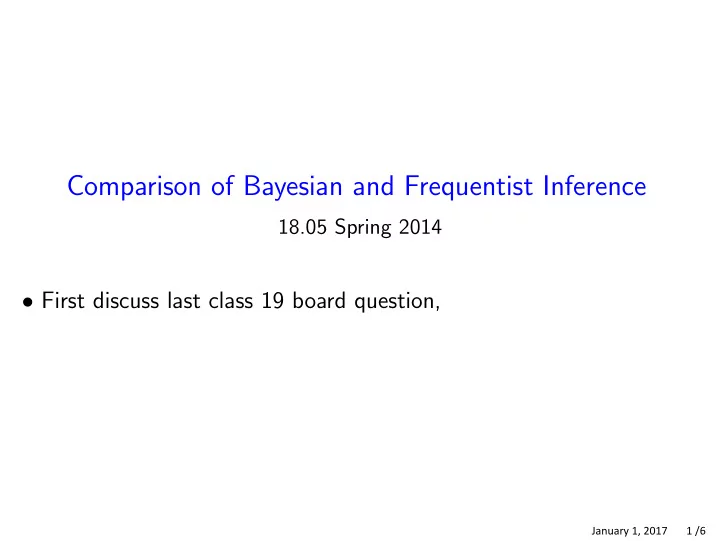

Comparison of Bayesian and Frequentist Inference 18.05 Spring 2014 • First discuss last class 19 board question, January 1, 2017 1 /6
Compare Bayesian inference Uses priors Logically impeccable Probabilities can be interpreted Prior is subjective Frequentist inference No prior Objective –everyone gets the same answer Logically complex Conditional probability of error is often misinterpreted as total probability of error Requires complete description of experimental protocol and data analysis protocol before starting the experiment. (This is both good and bad) January 1, 2017 2 /6
Concept question Three different tests are run all with significance level α = 0 . 05. 1. Experiment 1: finds p = 0 . 03 and rejects its null hypothesis H 0 . 2. Experiment 2: finds p = 0 . 049 and rejects its null hypothesis. 3. Experiment 3: finds p = 0 . 15 and fails to rejects its null hypothesis. Which result has the highest probability of being correct? (Click 4 if you don’t know.) answer: 4. You can’t know probabilities of hypotheses based just on p values. January 1, 2017 3 /6
Board question: Stop! Experiments are run to test a coin that is suspected of being biased towards heads. The significance level is set to α = 0 . 1 Experiment 1: Toss a coin 5 times. Report the sequence of tosses. Experiment 2: Toss a coin until the first tails. Report the sequence of tosses. 1. Give the test statistic, null distribution and rejection region for each experiment. List all sequences of tosses that produce a test statistic in the rejection region for each experiment. 2. Suppose the data is HHHHT . (a) Do the significance test for both types of experiment. (b) Do a Bayesian update starting from a flat prior: Beta(1,1). Draw some conclusions about the fairness of coin from your posterior. (Use R: pbeta for computation in part (b).) January 1, 2017 4 /6
Board question: Stop II For each of the following experiments (all done with α = 0 . 05) (a) Comment on the validity of the claims. (b) Find the true probability of a type I error in each experimental setup. By design Ruthi did 50 trials and computed p = 0 . 04. 1 She reports p = 0 . 04 with n = 50 and declares it significant. Ani did 50 trials and computed p = 0 . 06. 2 Since this was not significant, she then did 50 more trials and computed p = 0 . 04 based on all 100 trials. She reports p = 0 . 04 with n = 100 and declares it significant. 3 Efrat did 50 trials and computed p = 0 . 06. Since this was not significant, she started over and computed p = 0 . 04 based on the next 50 trials. She reports p = 0 . 04 with n = 50 and declares it statistically significant. January 1, 2017 5 /6
MIT OpenCourseWare https://ocw.mit.edu 18.05 Introduction to Probability and Statistics Spring 2014 For information about citing these materials or our Terms of Use, visit: https://ocw.mit.edu/terms.
Recommend
More recommend